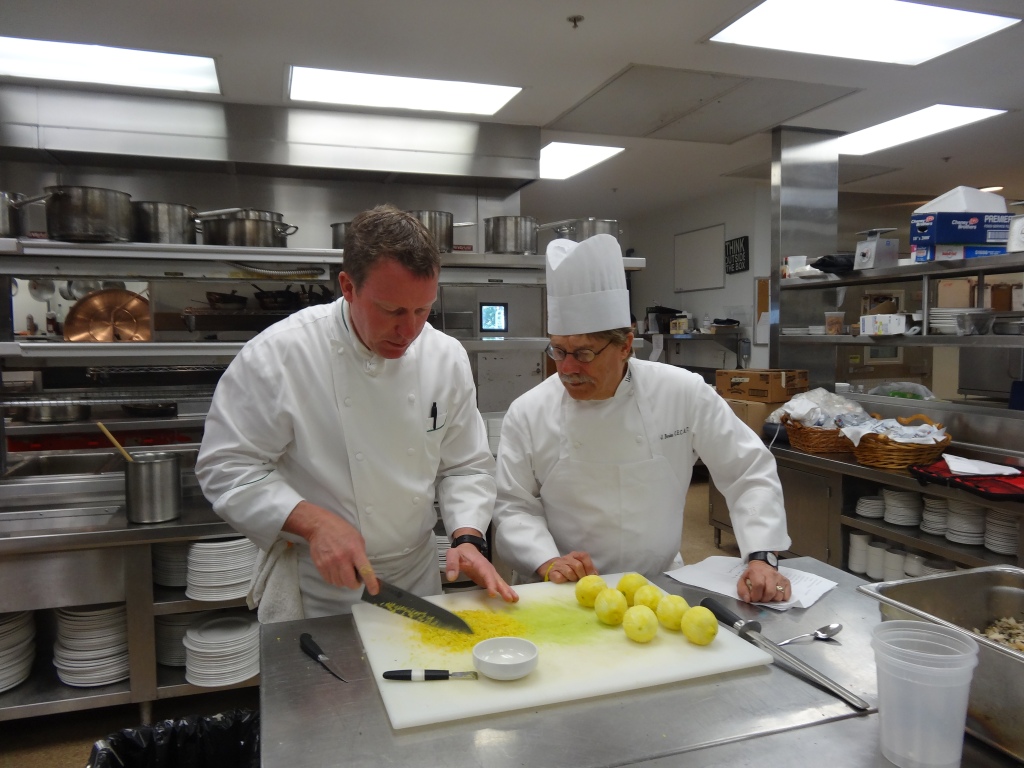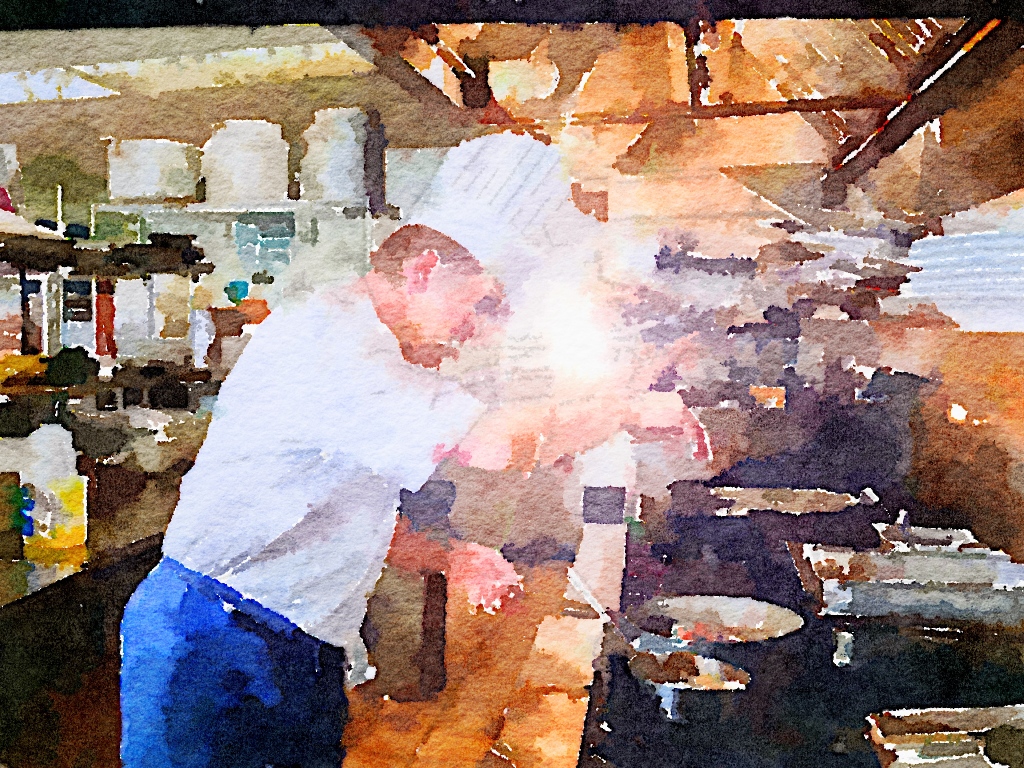
More than anything else, when I was in restaurant kitchens I looked forward to planning and testing the next set of menu changes. A stale menu is not cost effective, ignorant of quality issues with ingredients, uninspiring for employees, and just plain boring. It is a menu change that tests a chef’s ability to understand the seasonality of harvest, the connection that menu items have with the concept of the restaurant, executive cost-effective items, push the kitchen crew to enhance their skills, and excite the customer. Are you up to it?
Winter is, by far my favorite season to plan menus. This is where “real cooking” comes into play; where a chef demonstrates his or her ability to pull flavors out of seasonal ingredients and marry flavors to match the weather outside. Braising, Roasting, Barbeque, Stewing, Poaching, and any item that engages “low and slow” is appropriate in the winter months. Depending on where you live this season might last three months, or you could be in for the long haul. Northern New York State where I spent my career looks ahead to nearly six months of cold, snow, and an occasional ice storm.
Winter is the time when red wines jump to centerstage, when hearty IPA’s and sour ales are in demand, when hard cider, bourbon, single malt scotch, and barrel aged whiskeys take up much more shelf space behind your bar. It is the time when guests seek out restaurants with a fireplace, open wood fired kitchens, and the rich, deep smell of charred meats and fish, roasted crispy birds, sweet oven baked garlic, caramelized onions, and short ribs and shanks coming from a six hour braise. It is the season of butternut, acorn, delicata, and spaghetti squash roasting with plenty of butter and brown sugar, of roasted walnuts, pecans, and marcona almonds added to your salads, and in-house pickling finding its way onto your appetizer boards. Late season root vegetables like carrots, beets, and parsnips are on everyone’s list. This is the time for brussels sprouts to jump to a lead role on your menus, roasted, blanched and sauteed, char grilled or smoked – these former “second-class citizen” vegetables are now peaking in popularity.
For the chef interested in helping the bottom line – winter provides an opportunity to work with lesser cuts of meat and poultry, less frequently ordered fish, and dramatically enhance their perceived value through alternative cooking methods that draw out and combine flavors.
How are your menu planning skills? What experiences can you draw on in building this menu that moves quickly away from light and piquant to heavy and robust? There will always be room, even in the winter, for lighter menu items, complicated salads, grilled fish and steaks, and a load of tasty sauté dishes, but in the winter your guests will pull their chair up to a table ready, willing, and able to touch that fabulous, braised pork shoulder that falls off the bone. Are you ready?
Whenever I dove into the menu change process I worked with the following simple, but effective way to get from concept to plate:
[] DECIDE ON A DIRECTION
What will be the foundation of your menu? Will it be consistent throughout the seasons, or will it change at some level as the seasons do? As an example – Thomas Keller has a sign on his kitchen wall that says: “finesse”. Although there is no specific cuisine that stems from this, it does set the tone for every menu item, every preparation, and every moment of service. Epic restaurant in Georgia follows suit with “Culinary Pride” on their kitchen wall – again a driving concept that requires every person to ask themselves – does this dish, its flavor, the presentation, and the manner with which it is delivered reflect “Culinary Pride?”
I took a different approach in kitchens that I directed. Every menu and every menu item were drawn from a simple idea of “elegant comfort food”. I expected that every dish, no matter its origin or influence must reflect that feeling of familiarity and exceptional execution. Decide on a direction.
[] LET YOUR COOKS KNOW
A common mistake that chefs make (I have been there myself in the early days) was to assume that the menu is the chef’s, and only the chef’s responsibility. It must be, at some level, collaborative. If you want your cooks to be excited, your service staff to be proud, and your guests to receive exceptionally well-executed dishes, then everyone must feel like they had some input. Always be willing to listen to their ideas on how a dish might be prepared or presented better.
[] PULL TOGETHER RESOURCES TO STUDY
Never feel that it is somehow “cheating” to research through cookbooks, visiting other restaurants, or talking with professional peers and then re-creating an item that inspires you. Everyone does it at some level – that’s why cookbooks are around. I have a significant collection of books from all types of restaurants. Some I have not yet even paged through, but I know that at some point there will be inspiration for a dish or concept inside.
Keep in mind that a “recipe” is nearly impossible to protect under law (copyright, patent, trademark, etc.) so restaurants can and do freely use menu items that another may have “invented”. But be professional about using established items. If you add a named classical dish on your menu, then make it as it was originally developed, list it as “inspired by”, or make it uniquely yours. This is not required but it is the right way to conduct yourself as a chef.
[] LIST THOSE INGREDIENTS THAT WILL BE IN-SEASON & AVAILABLE
Restaurant chefs have become accustomed to accessing nearly any ingredient year-round. We know that every ingredient has a season unless we travel around the world to get it. The best menus take advantage of what is in season where you are. Asparagus is a spring vegetable, strawberries in June, apples in the early fall, Pacific halibut from June to September, spring lamb in May and June, etc. So, put together a chart of ingredient seasonality and hang it in your office. Let this be one of your important guides in preparing menus. Reference the Monterey Bay Seafood Watch research on seasonality and environmental challenges with certain types of seafood as well.
[] ATTACH A COST TO CENTER OF PLATE INGREDIENTS
Costing out recipes is time consuming unless you have support staff who can track that for you, however, you can keep a handle on a menu items’ cost by simply charting what your center of plate proteins cost and staying seasonal with their selection. Know that based on your concept there will always be a pricing ceiling that you should avoid. No matter how well the item is prepared and how exceptional it might be, if you exceed that price ceiling people will shy away from buying it.

[] PREP, TASTE, SEASON, TASTE
As a seasoned chef you may understand what a menu item will taste like simply by working it through your mind’s eye, but there are far too many variables that impact flavor when an original dish is created. Make sure that you include a trial-and-error phase to menu development and involve different people in the tasting process.
[] THINK COLORS AND TEXTURES ON A PLATE
Yes, taste is the ultimate attraction to a dish, but if it doesn’t look good on the plate then a guest’s flavor receptors will reject it. Any menu that is designed must also consider “plate presence”. Invest the time in beautiful as well as tasty menu items – the eyes play a role in determining flavor.
[] WORK IN YOUR SIGNATURE DESIGNS
This is where a chef can build his or her style as uniquely marketable. If you have a signature, then use it and build it into the menu conversation with your cooks and service staff. My “elegant comfort foods” had to focus on natural presentations. In other words, I expected that everything would flow in a natural fashion and would not be too contrived. I could “do contrived” but chose to avoid it with hot foods in particular.
[] THROW IT OUT TO YOUR KITCHEN CREW TO PLAY WITH
When you think that a menu item is “ready” then pass it off again to your kitchen team with the goal of making it better. You might be surprised at what will evolve.
[] COME UP WITH THREE VARIATIONS FOR EACH POTENTIAL ENTRÉE
If you want eight entrees on your new menu, then start by developing twelve with two or three slight variations for each. Through trial and error and a bit of democracy you will come up with the best of the best and everyone has some level of buy-in.
[] GIVE CREDIT WHERE CREDIT IS DUE
If one of your cooks came up with the idea that put a menu item over the top, then make sure they get loads of credit. You might even state on the physical men that the concept and specific menu items were a collaboration of ideas and put the names of your kitchen crew on the document. This simple act will really charge up your team.
[] MAKE SURE THAT IT HITS ALL OF YOUR STAKES IN THE GROUND
Whatever you hold close as essential to your philosophy of cooking must be adhered to, otherwise your buy-in will wane.
[] EDUCATE YOUR SERVICE STAFF
Your service staff members are on the front line. They interact with guests, they are the key salespeople, and they will suffer the most if a guest is unhappy. Take the time to explain the concept, the menu choices, the process used in development and require them to taste everything. Have your bar manager or sommelier offer a pairing tasting so that they know what beverages to recommend. Make them part of the whole process.
[] GIVE IT A TRY AND BE WILLING TO DELETE OR ADD IF NECESSARY
Finally, whenever a menu is developed, in this case for that time of the year when robust flavors are so exciting and ever-present, know that all your work may not lead to acceptance. If the guest doesn’t respond well then write it off as a learning experience and make adjustments to your menu. It must always be fluid until the guest says: “WOW”.
PLAN BETTER – TRAIN HARDER
Harvest America Ventures, LLC
Restaurant Consulting
www.harvestamericacues.com BLOG
More than 800 articles on everything about food and food people
CAFÉ Talks Podcast
https://cafemeetingplace.com/cafe-podcasts
Listen to more than 60 interviews with leading chefs, restaurateurs, and food influencers
PHOTOS:
- Chefs Charles Carroll, CEC – Executive Chef – River Oaks Country Club -Houston
- Chef Michael Beriau, CEC – Semi-Retired (waxing his skis for another winter)
- Chef Herve Mahe – Chef/Owner – Bistro de Margot – Burlington, VT

Leave a comment